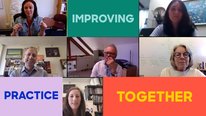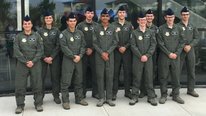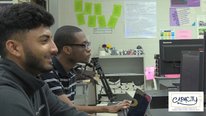- Pauline Lake
- Curriculum and Professional Development Coordinator
- Broadening Participation and Building Pathways in CS through Concurrent Enrollment
- http://mobile-csp.org/ce
- National Center for Computer Science Education
- Karen Binkhorst
- Coordinator
- Broadening Participation and Building Pathways in CS through Concurrent Enrollment
- http://mobile-csp.org/ce
- Capital Community College
- Renee Fall
- Senior Research Scholar
- Broadening Participation and Building Pathways in CS through Concurrent Enrollment
- http://mobile-csp.org/ce
- National Center for Computer Science Education
- Seth Freeman
- Chair, Professor
- Broadening Participation and Building Pathways in CS through Concurrent Enrollment
- http://mobile-csp.org/ce
- Capital Community College
- Dan Kaiser
- Chair, Professor
- Broadening Participation and Building Pathways in CS through Concurrent Enrollment
- http://mobile-csp.org/ce
- Southwest Minnesota State University
- Ryan Lindsay
- Mobile CSP through CE Master Teacher for MN
- Broadening Participation and Building Pathways in CS through Concurrent Enrollment
- http://mobile-csp.org/ce
- National Center for Computer Science Education, Saint Louis County Schools
- Jennifer Rosato
- Director
- Broadening Participation and Building Pathways in CS through Concurrent Enrollment
- http://mobile-csp.org/ce
- College of St. Scholastica, National Center for Computer Science Education
- James Veseskis
- Computer Science Teacher
- Broadening Participation and Building Pathways in CS through Concurrent Enrollment
- http://mobile-csp.org/ce
- National Center for Computer Science Education, Hartford Magnet Trinity College Academy
Public Discussion
Continue the discussion of this presentation on the Multiplex. Go to Multiplex














Pauline Lake
Curriculum and Professional Development Coordinator
Hi all! My name is Pauline Lake. I am the Curriculum and PD Coordinator for the National Center for Computer Science Education where I work with the Mobile CSP program. Our Mobile CSP Concurrent Enrollment (CE) team is super excited to share our project with you! Concurrent enrollment (CE) courses are college-level classes offered within high schools and taught by qualified high school teachers in association with a local community college or university. Sometimes they are also referred to as dual enrollment or college-in-the-schools programs. Our team looks at CE courses as an alternative to Advanced Placement (AP) courses. The Mobile CSP CE project aims to
If you have questions, ideas, or even feel that we have similar interests, please leave us a comment!
Kristin Flaming
Sarah Young
Director of Strategic Initiatives
Hi Pauline, great video, I appreciate hearing from both the teachers and the Mobile CSP Master Teachers for their different perspectives.
Does the network meet in person, or is the full experience online? I am interested to know more about the types of engagement that you employ throughout the program.
Ryan Lindsay
Mobile CSP through CE Master Teacher for MN
I am a master teacher on the project. By network, I am assuming you mean the grant team of researchers to master teachers. Our network meets online 1 or more times a month as well as in person for some packed days of work a few times a year. It has been really empowering to have a voice as a part of a research group. In some way, it brings a feeling of professionalism which can get lost at times in my little high school teaching bubble.
James Veseskis
Computer Science Teacher
Greetings
My name is James Veseskis and I a Master Teacher for the Mobile CSP program. I have been teaching for 25 years. I was one of the first teachers ever trained in this curriculum. We bring computer science to both rural and urban communities. I teach in an urban setting and also train teachers in incorporating equity practices into their classroom. I do not have a teaching certificate in computer science but social studies. Anyone can teach computer science if they have desire, the right training and support. I would be happy to answer any questions you may have.
Florence Sullivan
Jennifer Vermillion
Director of Innovative Teaching and Learning
I enjoyed your video and learning about your project! What are some of the barriers to implementing CS Principles as a CE course that you have discovered?
Michael I. Swart
James Veseskis
Computer Science Teacher
If you build it they still will not come. Recruit, Recruit, Recruit, especially females and under represented minority students. Many students do not see themselves in a Computer Science (CS) class because they never took a cs class. They have no frame of reference or prior knowledge. Not to mention the stereotypes. So, for me the personal one on one talks make the most difference. I really think you can do well in this class goes a long way. I also say do you like chocolate chip cookies. The first time you ever had one did you say no I am not trying that or did you take a bite? I really think you should take a bite. You might be surprised.
The other barrier for students is AP or CE credit? I personally favor the CE curriculum. The AP schedule can be very strict and when you have lots of days missed due to acts of nature the AP test can be unforgiving. Test day comes regardless of circumstances. This means you have to always be moving at a fast pace through the curriculum. A student with developed skills can handle this but the high school student who maybe college bound but is still developing their skills misses out on the computer science experience. The pace may be to fast for their current skill set.
With a CE class I still have to meet the requirements of the curriculum but I am not constrained by an additional AP timeline. For students who have never taken computer science before this may be a more comfortable fit. And many students have never taken computer science before.
So for me the bottom line is the CE offering is more equitable to students because the pace of the curriculum is more accessible to students at different skill set levels. Therefore I am reaching more students in my school.
Michael I. Swart
Carol Fletcher
Janice Cuny
Global DIrestor of Align
James, Can you say anything more about how you recruit, especially students from the underrepresented groups?
Carol Fletcher
I really like the idea of giving kids more options than just AP for obtaining college credit but combining this with the quality control of using the Mobile CSP curriculum, which was purposefully designed to be engaging, hands-on, project-based, and attractive to a broad range of students. So you get the consistency that AP generally has in its favor over most dual credit which is very instructor dependent, but meet the needs of students and schools for whom AP is not a good option. Do you have any issues with student perceptions that AP might be better for their transcript?
Jennifer Rosato
Director
Hi Carol,
I would say that it depends on the local context and the level of the decision-making (student vs school). Some areas prefer concurrent enrollment courses as they see it's more of a guarantee that students will earn college credit that might be more transferable to other colleges. For example, if the college is offering the CE course and it is part of a state system that has rules around transferring credit between state institutions, that means that the college credit will be valid at a range of institutions.
For some schools when administrators and teachers are considering what version to offer it in, there is a perception that AP courses are more prestigious than CE courses and how offering AP vs CE might impact a school's rating with the state. Again, this will vary by context as each state has different rule governing CE policies.
Jen
Carol Fletcher
James Veseskis
Computer Science Teacher
It depends on the student. Jen is right with the prestige perception. The higher performing students go for AP. However, economics can play a part for my students. Many lower income students will end up in our state system so the CE credit will benefit them.
We all dream of going to the top schools but economics usually limits choice. Again in my opinion CE can offer more of an economic advantage for students. If they are staying in the state system they just saved some tuition money.
Carol Fletcher
Florence Sullivan
This is a really important equity argument that you are making here, James. Dual enrollment options help low-income students save on tuition later and also give them a clear sense of accomplishment which can lead to greater feelings of belongingness at the college level. Very cool project!
Carol Fletcher
I totally agree James and Florence. I was a school board member for 18 years. Our district had a big focus on AP courses and was recognized by the College Board for the student enrollment reflecting the diversity of the district but as our demographics began to change we had to be more open to dual enrollment options for the increasing number of economically challenged families that we served who needed more of a guarantee that if they put in the work, they would get the credit. Our principals felt much more confident in the quality our own master teachers who taught AP than in rolling the dice with a CC instructor that they didn't know. What your project adds here is the quality control factor that seems to be missing from many of the dual enrollment options I have seen. Kudos to you!
Ryan Lindsay
Mobile CSP through CE Master Teacher for MN
I am a Master Teacher for Minnesota on the project. It has been fascinating to learn about the differences in school systems within states as well as between states. I taught the AP version for a few years in our rural area, but the prestige factor is not present here. In fact, it was a constant battle to convince the public, students and admin it had merit. The concurrent enrollment model is something that is understood here and systems are in place for success.
Kacy Redd
Do you have plans to expand to other institutions? Are you engaging the disciplinary societies in your work?
Renee Fall
Senior Research Scholar
We hope so! We are focusing on our two partner post-secondary CE programs to pilot through 2020-21 school year, but we will be exploring the impact and possible expansion of this model. We will be hosting a panel on offering CS through CE on May 20 (sponsored by NCCSE, so watch for details there), which includes 2 other campuses that offer CS as CE.
Our college faculty participate in their CS disciplinary societies, and we are engaged with associations and conferences for CS education and broadening participation,
Annie Leonard
This model resonates with me as a former principal in a rural, under-resourced district. I'm curious how you are measuring outcomes, not just for individual students, but for teachers and on participating schools more broadly?
Seth Freeman
Chair, Professor
Annie,
Thanks for your question regarding outcomes. For students enrolled in the college courses, the outcomes are related to how well the demographics of the students taking the CSP course match with the overall school demographics, and the success rates of the students taking the course. For teachers, the outcomes relate to teacher preparedness to effectively teach the CSP course as CE, and more broadly teacher preparation to teach CS.
More broadly for schools/districts, outcomes include how participation in concurrent enrollment supports student retention, graduation, and continuation into post-secondary. Regarding CS pathways, we would love to know if and how this course by itself - or as part of a CS/IT pathway - impacts students continuing to major in CS/IT at the secondary level and/or entry-level employment. These are longer-term outcomes, however, and difficult to measure during a 3-year project period.
Your question is helpful - because outcomes for schools/districts - and outcomes for CE programs at the colleges/universities are generally the same - but not always completely in-line - which speaks to the need for frequent communication and closer partnerships.
Jill Denner
This is an ambitious project and it sounds like you have had some real successes. Can you share any challenges you have faced in building a pathway across institutions, and (ideally) how you addressed those challenges?
Ryan Lindsay
Mobile CSP through CE Master Teacher for MN
One seemingly obvious but important challenge is aligning timelines of the project team, college systems and high school institutions. Getting the class on the schedule, students signing up for the course, and training appropriate personnel for recruitment at each institution involves lots of moving parts. The research team did interviews, surveys and likely other work to compile meaningful calendars and deadlines. For example, it wasn't initially at the forefront that high school course sign up may happen as January for the following fall. That really impacts when you offer recruitment training sessions or teacher recruitment.
Jill Denner
Janice Cuny
Global DIrestor of Align
This is an important project as CE has become increasingly popular around the country. It's a great place for students to on ramp into computing.
James Veseskis
Computer Science Teacher
To answer your question about recruiting. This is a long post but I felt the context was more important then just listing ways of recruiting.
First, I wish I could say there is an easy, one-size-fits-all way to recruit, but every student is an individual,and each is motivated in different ways. Each will respond to different stimuli, so my job is to identify that stimuli. Still, there are some activities that have more universal impact than others, so I will highlight those here.
Puppies, Pizza & Programming = CS Visibility:
At the 2014 100 Teacher Computer Science Teacher conference (which I believe you organized) I spoke with Seth Rechelson about his recruiting strategies. To this day I use some of his ideas, including pizza, puppies and programming at our school showcase. Overarchingly, the goal is to make computer science one of the most visible classes in the school. Everyone stops for puppies and a slice of pizza. Does the pizza taste good? Hey . . . check out this app. The President of Trinity College was so impressed by the effort that she put us on her Twitter page.
Messaging: Everyone Can Do Computer Science:
I stress with my team leaders that I want every student in my class. I especially request students with disabilities. We often overlook this demographic when recruiting for computer science. A constant message to my colleagues is -- Give me everyone because computer science is for ALL.
Leveraging External Organizations/Prizes:
The National Center for Women and Information Technology (NCWIT) is a good example of leveraging external organizations. During my second year teaching CS I had one African American freshman girl placed into my AP CSP class. She did try to drop, but I convinced her to stay and had her fill out the Aspirations in Computing award. She received the state award. This was the true start to building a computer science program, and it raised the overall profile of computer science in the school. Once other girls saw the trophy other girls started to pay more attention since prizes could be attached to successful participation.
Prizes/Peer-to-Peer:
Another example along these lines included a female student who entered the Aspirations in Computing Award contest; she was recognized for her leadership ability and was asked to apply for the AspireIT Award. She has received the $3,000 award for three consecutive years, and she became a peer recruiter. She now trains middle school and elementary school girls in App Inventor. Other high school students have followed suit, and they do my early recruiting for me, particularly with the younger girls. All freshman girls in my AP CSP class have been mentored by this process. Students pay more attention if their peers are running things (as opposed to a less cool 50-year-old man, like me). They are brand ambassadors, and they effectively bring large groups of students to my class.
Competitions:
Some students respond to competition. So, for those students we enter our apps into app competitions. Some students in my school have won the House of Representative App Challenge, and one female group was a semifinalist in the Technovation Challenge.
Pop Culture Activities:
I run small, relatable activities, sometimes with prizes. I stole the hot pepper challenge from Netflix and a show called “The Secret Rules of Modern Living.” At PTO or other events, it may be a teacher vs. parent challenge. The parent cannot “win,” but I offer to put names into a raffle for a $50 gift card if you do the challenge. As participants are drinking their milk we talk about computer science. I also go into the 8th grade math classes and do the challenge during the class selection process. These things keep my name on their mind. During that time the principal has let me give a five-minute pitch on “Why Computer Science.” So, my class is the last thing discussed before they are dismissed and select courses.
One on One:
The number one way I get students is the personal one on one. Getting to know the student either in another class or school activity and asking: Did you ever consider computer science?That one question coupled with five to ten minutes of encouragement and interest in the student’s future can make all the difference. In the end, if you build it they still may not come. You may have to walk them up to the entrance, open the door, and nudge them in. Then, others may come, too.
There are other things to discuss regarding recruitment. If you would like to talk more please let me know. My school did receive the College Board diversity award for the 2018-2019 school year. I live, breathe and eat equity and promote computer science not only in my school but across the state, so I am happy to set aside time to speak with you about this.
Janice Cuny
Global DIrestor of Align
Ahh, Seth's Pizza, Puppies and Programming tip from the 100 Teacher's meeting. Glad to see it lives on!!
Terrific list of outreach efforts. Thanks! It seems very comprehensive but it would be interesting to see if any other Showcase viewers have suggestions as well.
Saira Mortier
Very important program. Keep up the good work! What has been your biggest challenges and successes with Mobile CSP?
Pauline Lake
Curriculum and Professional Development Coordinator
Hi Saira, thank you for watching our video and commenting! While we do have research results that can speak to this, my response is more so a personal one and based on personal observations.
One of the biggest successes Mobile CSP has had is the support we provide for teachers. Our teacher participants often mention that they feel supported by their cohort and Master Teacher as well as by the online community that we have that allows teachers to get just-in-time responses when they need help just before or during a class session.
One of our biggest challenges, from my viewpoint, has been recruitment over the past couple of years. There are many different "flavors" of CSP and each curriculum/provider has different offerings. This seems to cause teachers to choose one that fits with their needs and school the best. For a while we had trouble recruiting teachers from schools that use iPads, for example, because we use MIT App Inventor which was originally only for Android. That is no longer the case - so I'm hopeful we'll get more teachers.
-Pauline
Deb Hall
What a nifty cool way to simultaneously encourage a high school student's pursuit of a career in Computer Science and of their completion of a college degree!
Have you reached out to local area elementary and middle schools to also get those students and their parents excited about this upcoming opportunity for them when they reach high school? In Florida, our Dual Enrollment students can start in the 6th grade. I personally have not had students that young in any of my of engineering technology courses, but I have been told to be prepared because it is possible if a parent is wiling to drive them to and from our college campuses.
Seth Freeman
Chair, Professor
Hi Deb,
Thanks for your question regarding recruiting in earlier grade levels. In our Concurrent Enrollment program at Capital Community College, we have not routinely reached out to elementary or middle schools to promote this opportunity. Currently, only students in 10th, 11th and 12th grades are eligible to receive college credit.
I agree promoting our dual enrollment program in middle schools would be a great way of informing parents and students about this opportunity. For parents, we want to highlight the cost-savings families can obtain by students earning up to 15 college credits while in high school. There is also an opportunity for us to work with our partnering school districts more to ensure their school catalogs highlight these pathways and college credit opportunities.
Pauline Lake
Curriculum and Professional Development Coordinator
Deb, thanks so much for watching our video and commenting! I think this is a great suggestion. Our CE college/university teams do most of the recruiting in their areas. We have representatives from SMSU and CC as co-presenters here. I am wondering if they can respond on whether or not they have reached out to the elementary and middle schools?
-Pauline
Michael I. Swart
Great project. Can you expound on aspects of the curriculum, specifically collaboration and creative co-construction? Is there an online resource that students who participate in the program can share their work? Ideas?
What kind of data does this project produce for content knowledge, PD efficacy, teacher learning/perspective, student learning/perspective/motivations/interests?